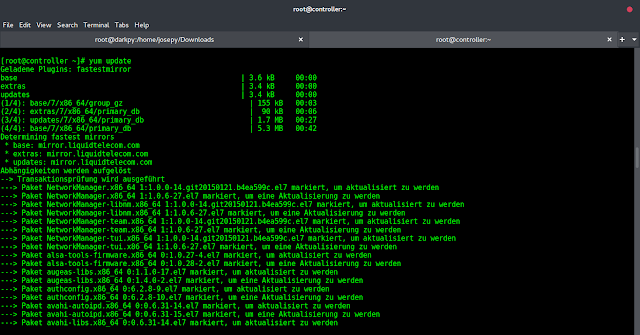DateField is a field that stores date, represented in Python by a datetime.date instance. As the name suggests, this field is used to store an object of date created in python. The default form widget for this field is a TextInput. The admin can add a JavaScript calendar and a shortcut for “Today” explicitly.
Syntax:
field_name = models.DateField(**options)
DateField has the following extra optional arguments –
DateField.auto_now
- Automatically set the field to now every time the object is saved. Useful for “last-modified” timestamps. Note that the current date is always used; it’s not just a default value that you can override.
The field is only automatically updated when calling Model.save(). The field isn’t updated when making updates to other fields in other ways such as QuerySet.update(), though you can specify a custom value for the field in an update like that.
DateField.auto_now_add
- Automatically set the field to now when the object is first created. Useful for creation of timestamps. Note that the current date is always used; it’s not just a default value that you can override. So even if you set a value for this field when creating the object, it will be ignored. If you want to be able to modify this field, set the following instead of auto_now_add=True:
- For DateField: default=date.today – from datetime.date.today()
- For DateTimeField: default=timezone.now – from django.utils.timezone.now()
Note: The options auto_now_add, auto_now, and default are mutually exclusive. Any combination of these options will result in an error.
Django Model DateField Explanation
Illustration of DateField using an Example. Consider a project named neveropen having an app named Lazyroar.
Refer to the following articles to check how to create a project and an app in Django.
Enter the following code into the models.py file of Lazyroar app.
Python3
from django.db import modelsfrom django.db.models import Model# Create your models here.class GeeksModel(Model): Lazyroar_field = models.DateField() |
Add the Lazyroar app to INSTALLED_APPS
Python3
# Application definitionINSTALLED_APPS = [ 'django.contrib.admin', 'django.contrib.auth', 'django.contrib.contenttypes', 'django.contrib.sessions', 'django.contrib.messages', 'django.contrib.staticfiles', 'Lazyroar',] |
Now when we run makemigrations command from the terminal,
Python manage.py makemigrations
A new folder named migrations would be created in Lazyroar directory with a file named 0001_initial.py
Python3
# Generated by Django 2.2.5 on 2019-09-25 06:00from django.db import migrations, modelsclass Migration(migrations.Migration): initial = True dependencies = [ ] operations = [ migrations.CreateModel( name ='GeeksModel', fields =[ ('id', models.AutoField( auto_created = True, primary_key = True, serialize = False, verbose_name ='ID' )), ('Lazyroar_field', models.DateField()), ], ), ] |
Now run,
Python manage.py migrate
Thus, an Lazyroar_field DateField is created when you run migrations on the project. It is a field to store datetime.date python object.
How to use DateField ?
DateField is used for storing python datetime.date instance in the database. One can store any type of date using the same in the database. Let’s try storing a date in model created above.
Python3
# importing the model# from Lazyroar appfrom Lazyroar.models import GeeksModel# importing datetime moduleimport datetime# creating an instance of# datetime.dated = datetime.date(1997, 10, 19)# creating an instance of# GeeksModelgeek_object = GeeksModel.objects.create(Lazyroar_field = d)geek_object.save() |
Now let’s check it in admin server. We have created an instance of GeeksModel.
Field Options
Field Options are the arguments given to each field for applying some constraint or imparting a particular characteristic to a particular Field. For example, adding an argument null = True to DateField will enable it to store empty values for that table in a relational database.
Here are the field options and attributes that a DateField can use.
| Field Options | Description |
|---|---|
| Null | If True, Django will store empty values as NULL in the database. Default is False. |
| Blank | If True, the field is allowed to be blank. Default is False. |
| db_column | The name of the database column to use for this field. If this isn’t given, Django will use the field’s name. |
| db_index | If True, a database index will be created for this field |
| db_tablespace | The name of the database tablespace to use for this field’s index, if this field is indexed. The default is the project’s DEFAULT_INDEX_TABLESPACE setting, if set, or the db_tablespace of the model, if any. If the backend doesn’t support tablespaces for indexes, this option is ignored. |
| Default | The default value for the field. This can be a value or a callable object. If callable it will be called every time a new object is created. |
| help_text | Extra “help” text to be displayed with the form widget. It’s useful for documentation even if your field isn’t used on a form. |
| primary_key | If True, this field is the primary key for the model. |
| editable | If False, the field will not be displayed in the admin or any other ModelForm. They are also skipped during model validation. Default is True. |
| error_messages | The error_messages argument lets you override the default messages that the field will raise. Pass in a dictionary with keys matching the error messages you want to override. |
| help_text | Extra “help” text to be displayed with the form widget. It’s useful for documentation even if your field isn’t used on a form. |
| verbose_name | A human-readable name for the field. If the verbose name isn’t given, Django will automatically create it using the field’s attribute name, converting underscores to spaces. |
| validators | A list of validators to run for this field. See the validators documentation for more information. |
| Unique | If True, this field must be unique throughout the table. |





